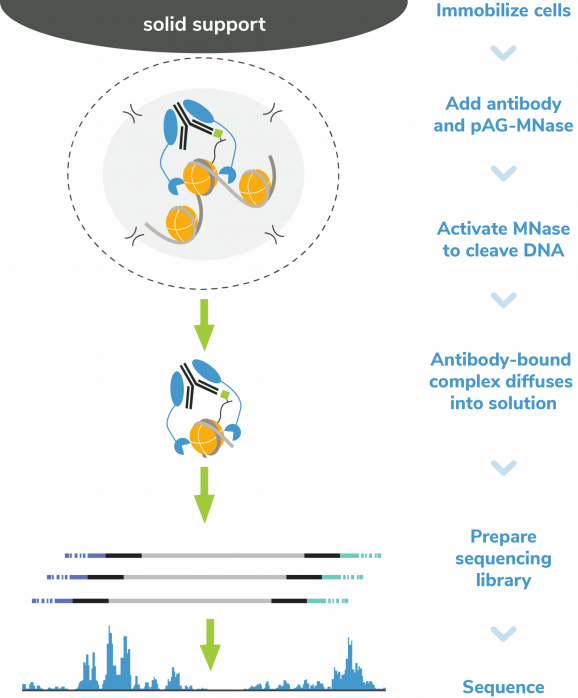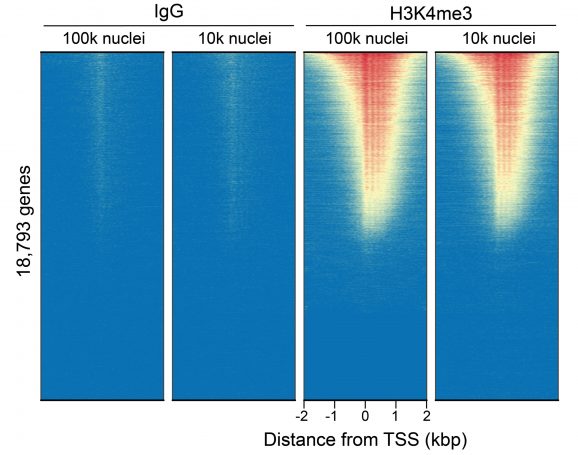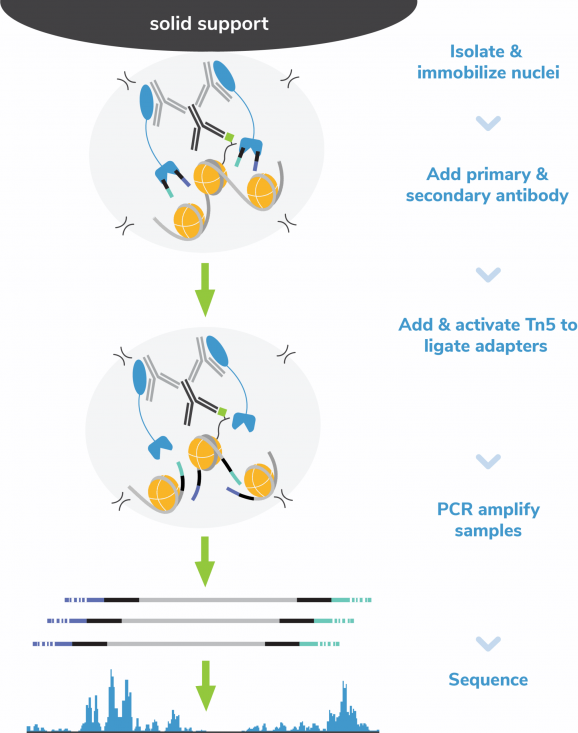H3K4me3 Antibody, SNAP-Certified™ for CUT&RUN and CUT&Tag
In stock
This H3K4me3 (histone H3 trimethylated at lysine 4) antibody meets EpiCypher’s lot-specific SNAP-Certified™ criteria for specificity and efficient target enrichment in both CUT&RUN and CUT&Tag applications. This requires <20% cross-reactivity to related histone PTMs determined using the SNAP-CUTANA™ K-MetStat Panel of spike-in controls (EpiCypher 19-1002, Figures 1 and 5). High target efficiency is confirmed by consistent genomic enrichment at varying cell inputs: 500k and 50k cells in CUT&RUN (Figures 2-3); 100k and 10k cells in CUT&Tag (Figures 6-7). High efficiency antibodies display similar peak structures (Figures 3 and 7) and highly conserved genome-wide signal (Figures 2 and 6) even at reduced cell numbers. This antibody targets histone H3K4me3, which is enriched at active promoters near transcription start sites (TSS) and promotes gene activation.
Validation Data
Figure 1: SNAP specificity analysis in CUT&RUN
CUT&RUN was performed as described in Figure 4. CUT&RUN sequencing reads were aligned to the unique DNA barcodes corresponding to each nucleosome in the K-MetStat panel (x-axis). Data are expressed as a percent relative to on-target recovery (H3K4me3 set to 100%). The antibody showed highly specific recovery of H3K4me3 spike-in nucleosomes at both 500k and 50k cells.
Figure 2: CUT&RUN genome-wide enrichment
Figure 3: H3K4me3 CUT&RUN representative browser tracks
Figure 4: CUT&RUN methods
CUT&RUN was performed on 500k and 50k K562 cells with the SNAP-CUTANA™ K-MetStat Panel (EpiCypher 19-1002) spiked-in prior to the addition of 0.5 µg of either IgG negative control (EpiCypher 13-0042) or H3K4me3 antibodies. The experiment was performed using the CUTANA™ ChIC/CUT&RUN Kit v3 (EpiCypher 14-1048). Library preparation was performed with 5 ng of CUT&RUN enriched DNA (or the total amount recovered if less than 5 ng) using the CUTANA™ CUT&RUN Library Prep Kit (EpiCypher 14-1001/14-1002). Both kit protocols were adapted for high throughput Tecan liquid handling. Libraries were run on an Illumina NextSeq2000 with paired-end sequencing (2×50 bp). Sample sequencing depth was 3.5 million reads (IgG 500k cell input), 4.0 million reads (IgG 50k cell input), 5.6 million reads (H3K4me3 500k cell input), and 2.8 million reads (H3K4me3 50k cell input). Data were aligned to the hg19 genome using Bowtie2. Data were filtered to remove duplicates, multi-aligned reads, and ENCODE DAC Exclusion List regions.
Figure 5: SNAP specificity analysis in CUT&Tag
CUT&Tag was performed as described in Figure 8. CUT&Tag sequencing reads were aligned to the unique DNA barcodes corresponding to each nucleosome in the K-MetStat panel (x-axis). Data are expressed as a percent relative to on-target recovery (H3K4me3 set to 100%). The antibody showed highly specific recovery of H3K4me3 spike-in nucleosomes at both 100k and 10k nuclei.
Figure 6: CUT&Tag genome-wide enrichment
Figure 7: H3K4me3 CUT&Tag representative browser tracks
Figure 8: CUT&Tag methods
CUT&Tag was performed on 100k and 10k K562 nuclei with the SNAP-CUTANA™ K-MetStat Panel (EpiCypher 19-1002) spiked-in prior to the addition of 0.5 µg of either IgG negative control (EpiCypher 13-0042) or H3K4me3 antibodies. The experiment was performed using the CUTANA™ CUT&Tag Kit v1 (EpiCypher 14-1102/14-1103). Libraries were run on an Illumina NextSeq2000 with paired-end sequencing (2×50 bp). Sample sequencing depth was 1.3 million reads (IgG 100k nuclei input), 2.0 million reads (IgG 10k nuclei input), 6.9 million reads (H3K4me3 100k nuclei input), and 10.6 million reads (H3K4me3 10k nuclei input). Data were aligned to the hg19 genome using Bowtie2. Data were filtered to remove duplicates, multi-aligned reads, and ENCODE DAC Exclusion List regions.
- Type: Monoclonal [2909-3D7]
- Host: Rabbit
- Applications: CUT&RUN, CUT&Tag
- Reactivity: Human, Wide Range (Predicted)
- Format: Protein A affinity-purified
- Target Size: 15 kDa
- CUT&RUN: 0.5 µg per reaction
- CUT&Tag: 0.5 µg per reaction
- Uniprot ID: H3.1 – P68431
- Alternate Names: H3, H3/a, H3/b, H3/d











